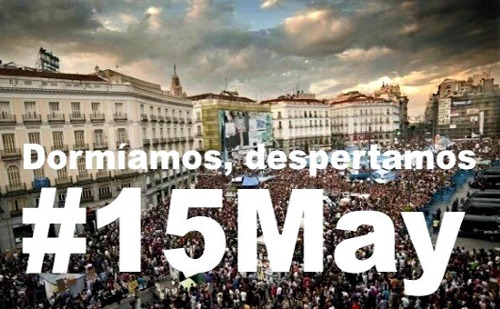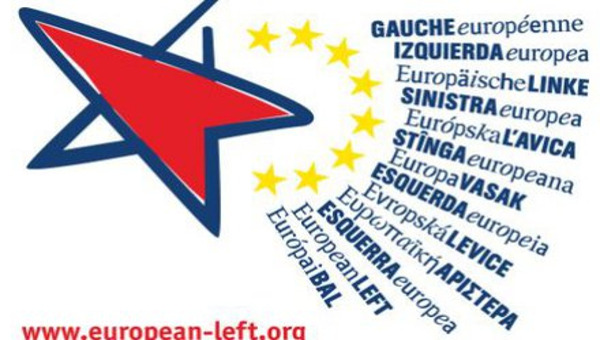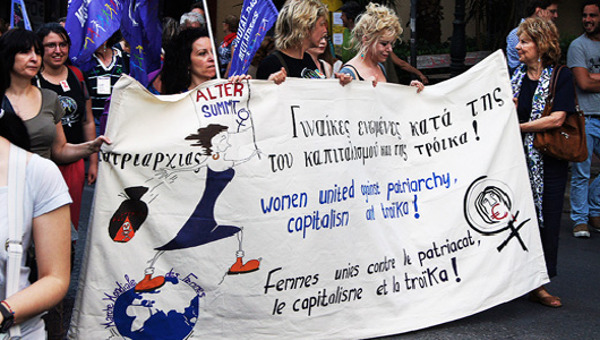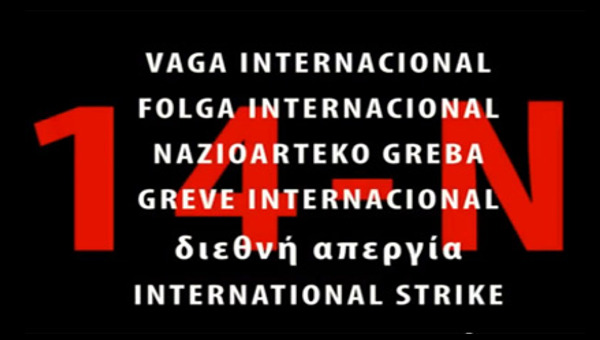United Europe Represses the Right to Protest Against NATO
On April 4th the leaders of the NATO member countries met on the French-German border in Strasbourg France for the 60th anniversary of NATO. At this meeting the U.S. was to propose an escalation of the war in Afghanistan and ask for greater troop commitment from NATO countries.
A major demonstration was organized to oppose this meeting, the occupation of Afghanistan, and to call for the dismantling of NATO. This demo also happened to coincide with the end of my time in Belarus, just days before my flight out of Germany back to Canada, so I was able to attend.
What Happened in Strasbourg
French President Nicolas Sarkozy had ordered every possible measure be used to put down the demonstration. But while he succeeded in stopping the protesters from setting foot in the streets of Strasbourg, the demonstration was all that was to be seen of the NATO summit in the news and the public imagination. In part, this can be seen as a victory of the demonstration: the state had pulled all the stops to suppress the voices of the street opposition to NATO, and the street had refused to be silenced. That the voice of this street appeared in the media stripped of criticism of NATO should not be surprising – it would not have been regardless of the specific behavior of some of the demonstrators.
Before the demo began its course was set. Nearly two thousand protesters, some Black Bloc, some Clowns, some independent activists, some organized socialists, had set up camp to the south of Strasbourg. This camp had been negotiated with the government by the International Coordinating Committee, because the government had refused better accommodations to the protesters. But from the beginning of the camp – on Wednesday night, four days before the demo – the police began to attack it, harassing and provoking the Black Bloc. From Wednesday night on, the police attacked the camp with tear gas, provoking fights with the Black Bloc, sealing the protesters in and harassing them in their temporary ghetto.
In official circles the International Coordinating Committee (ICC) also met with blocks from the state. Up until the night before the demonstration the government would not agree to a march route, a rallying point, or even to the legality of the demonstration. The state was maneuvering with the intention of shutting the demonstrators out of the NATO summit entirely.
The plan, which the ICC had set with the state months in advance, was that a German contingent would meet on the German side of the ‘Europe Bridge’ (the open German-French border bridge symbol of a united Europe) and a French contingent would meet on the French side. The demonstration would begin with the two sides meeting in the centre of the bridge and then marching back to the French side for a rally and continued march. The organizers wanted the march to lead into the city of Strasbourg from there to oppose the NATO meeting happening at the European parliament. Protest as usual. But no.
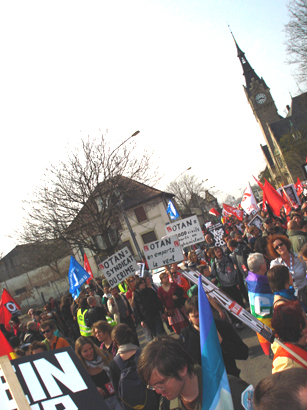 The day before the demonstration the police sealed off the centre of Strasbourg – which is ringed with canals and accessible by foot and car bridges – with armed guards in riot gear, gates, and high fences. The morning of the demo they intensified this blockade and completely cut off the rallying point from anyone staying on the north side of the city, where I was staying. After scouting numerous routes, I settled for a two hour walk around the long periphery of the city to get to the rallying point. But long before reaching the Europe bridge, the sound of tear gas cannons already filled the streets.
The day before the demonstration the police sealed off the centre of Strasbourg – which is ringed with canals and accessible by foot and car bridges – with armed guards in riot gear, gates, and high fences. The morning of the demo they intensified this blockade and completely cut off the rallying point from anyone staying on the north side of the city, where I was staying. After scouting numerous routes, I settled for a two hour walk around the long periphery of the city to get to the rallying point. But long before reaching the Europe bridge, the sound of tear gas cannons already filled the streets.
I have been going to demonstrations for about fifteen years, and the police repression at this demo shocked me. They were not only attacking Black Bloc participants either. As example, after the police had broken up the organized rally and driven the protesters back onto a train bridge, a group of mostly older peace activists stood facing the advancing police with their hands over their heads. The Black Bloc was no where around us. Even I was surprised when the cops fired a volley of a dozen tear gas canisters high up directly at this line of people with hands in the air. These people turned and scrambled, slid, ran down the steep bank, through the blackberry bushes and to the street below.
The police were working very hard to provoke the Black Bloc as rationale for attacking the protest as a whole.
Two fires were set: a border office and a government visa building. The police – completely in control of the area around the visa office – waited two hours before calling the fire trucks in, letting the fire take over the building and spread on to burn a pharmacy and a hotel. Of course, the cops, the government, and the media blamed the protesters for the burning of the pharmacy and the hotel in a working class part of town… but no one knows who started this particular fire. When I was asked by a media rep about the police claim that it was protesters, I said that I was very suspicious of such police claims.
 The police were clearly herding the crowd. Firing gas from lockdown positions to drive the crowd down a certain street, easing off and letting the march go in the direction they’d driven it, firing gas again to stop us from moving down side streets, then easing off again. The march seemed completely out of the control of the organizers. My experience was that there were no organizers in sight, only the organization of some of the socialist groups who tried to hold together their contingents and the organization of the Black Bloc which rushed furiously around the periphery of the march in constant battle with the police. Finally the police herded us into their planned dead end: an industrial area with warehouses on each side with walls and fences bordering the street on each side.
The police were clearly herding the crowd. Firing gas from lockdown positions to drive the crowd down a certain street, easing off and letting the march go in the direction they’d driven it, firing gas again to stop us from moving down side streets, then easing off again. The march seemed completely out of the control of the organizers. My experience was that there were no organizers in sight, only the organization of some of the socialist groups who tried to hold together their contingents and the organization of the Black Bloc which rushed furiously around the periphery of the march in constant battle with the police. Finally the police herded us into their planned dead end: an industrial area with warehouses on each side with walls and fences bordering the street on each side.
A line of police cut us off at the front end, and the cops rolled a pair of freight train cars in to block the street behind us. They were so prepared for this trap that they had readied a train to barricade us into a blocked position in this street. They took position on top of and around this train and, with the crowd completely immobilized, began again to fire tear gas into the crowd from each end apparently with no other intention than to break the heart of the demonstration.
The Left Organization(s)
 Some difficulties within the French left were laid bare at the anti-NATO demonstration. On one hand, an impressively broad coalition had been pulled together to organize the demonstration. It was composed of a disparate and usually divided collection of organizations, parties, trade unions, and parliamentarians. But on the other hand, this coalition was unable to act as a coalition in a united way. This showed in the indecisiveness and lack of cohesive leadership in the face of state blocks in advance of the demonstration, against severe police repression, and also in the lack of political cohesion in presentation of demands on the face of the demonstration. There was no clear central demand rising out of the chaos of the day, no coalition made signs for independent demonstrators to carry. Some of this could have been remedied by a rally, if a rally had been allowed to happen. But this division hampered the ability of the demonstration to present itself politically (beyond the fact of the demonstration itself) and laid the demo vulnerable to the manipulations of the state in advance and the attacks and repressions of the police in the midst. In the chaos that resulted from this situation, the Black Bloc – although only two thousand amongst some thirty thousand demonstrators – emerged as a deciding force that played a disproportionate role in the character of the demonstration. In terms of their specific goals within the demonstration, they were better organized and more cohesive than the main demo. Also, the state created a chaotic situation which was better suited to the operation of the Black Bloc.
Some difficulties within the French left were laid bare at the anti-NATO demonstration. On one hand, an impressively broad coalition had been pulled together to organize the demonstration. It was composed of a disparate and usually divided collection of organizations, parties, trade unions, and parliamentarians. But on the other hand, this coalition was unable to act as a coalition in a united way. This showed in the indecisiveness and lack of cohesive leadership in the face of state blocks in advance of the demonstration, against severe police repression, and also in the lack of political cohesion in presentation of demands on the face of the demonstration. There was no clear central demand rising out of the chaos of the day, no coalition made signs for independent demonstrators to carry. Some of this could have been remedied by a rally, if a rally had been allowed to happen. But this division hampered the ability of the demonstration to present itself politically (beyond the fact of the demonstration itself) and laid the demo vulnerable to the manipulations of the state in advance and the attacks and repressions of the police in the midst. In the chaos that resulted from this situation, the Black Bloc – although only two thousand amongst some thirty thousand demonstrators – emerged as a deciding force that played a disproportionate role in the character of the demonstration. In terms of their specific goals within the demonstration, they were better organized and more cohesive than the main demo. Also, the state created a chaotic situation which was better suited to the operation of the Black Bloc.
At first I had a hard time understanding why people were tolerating the Black Bloc at all, until I understood that they are a part of the French and German left / social movement, with a long history of a sort of co-existence with the other tendencies of this movement. Some aspects of this co-existence were visible when they would provide medical assistance to people overwhelmed by gas, and when some of them attacked a post office the crowd around them booed, and they stopped. As a World Social Forum organizer explained it to me, the Black Bloc is there, they are made by society too – the question is not whether to work with them, but how.
But more important than the Black Bloc – which is a comparatively static movement – the most interesting and encouraging aspect of the demonstration for me was the role of the French New Anti-Capitalist Party (NPA).
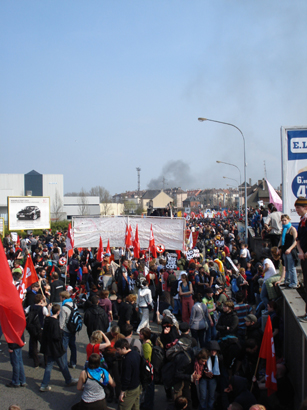 When the crowd was trapped between lines of police with individuals breaking off with their hands over their heads, most of the left parties and organizations also headed for the hills. It’s not our fight, they said. But in this environment the NPA stood their ground. They dismantled the pallet barricades and formed three front lines of activists with arms interlocked at the head of a retreat. Some of their leaders went on and made the hard – but completely necessary – decision to negotiate a retreat with the police. These leaders were verbally attacked for these negotiations by some in the rally, but if the crowd was allowed to remain trapped any longer the slow disintegration would put people in serious danger – the NPA realized this and made a move that showed real movement leadership. I joined arms in their lines of activists to lead the crowd out from the trap we were in. These street leader activists were uniformly young, spirited, calm, and morally disciplined. Some of these young people I spoke to had been members of the Revolutionary Communist League (LCR) before it dissolved into the NPA, and some of them were new members or sympathizers of the NPA.
When the crowd was trapped between lines of police with individuals breaking off with their hands over their heads, most of the left parties and organizations also headed for the hills. It’s not our fight, they said. But in this environment the NPA stood their ground. They dismantled the pallet barricades and formed three front lines of activists with arms interlocked at the head of a retreat. Some of their leaders went on and made the hard – but completely necessary – decision to negotiate a retreat with the police. These leaders were verbally attacked for these negotiations by some in the rally, but if the crowd was allowed to remain trapped any longer the slow disintegration would put people in serious danger – the NPA realized this and made a move that showed real movement leadership. I joined arms in their lines of activists to lead the crowd out from the trap we were in. These street leader activists were uniformly young, spirited, calm, and morally disciplined. Some of these young people I spoke to had been members of the Revolutionary Communist League (LCR) before it dissolved into the NPA, and some of them were new members or sympathizers of the NPA.
The NPA acted in the interests of and as part of the social movement, and they bore a great deal of responsibility. From what I saw, they are true to their claims of being a movement based, pluralist anti-capitalist party; distinctly different from the attitudes and behaviors of a sect.
During the retreat through the lines of cops the crowd was attacked again and again, four or five times, with tear gas at close proximity. Each time the NPA would form a tight formation to maintain the grouping of the crowd, wait out the effects of the gas, and then loosen and march on. They waited until everyone was clear of the police lines then we pushed the train cars out of the street by hand and marched on.
After the Demonstration
The police repression in Strasbourg continued after the demonstration was over. All trains to Germany were shut down and police blockades of bridges and streets were replaced with police check points for the day after the demonstration. All young people, and particularly Arab and Black appearing youth were stopped, searched, and forced to produce documentation in the streets. People were detained, photographed, and fingerprinted if found with fliers related to the demonstration or NATO. I saw the racist harassment everywhere while I walked the streets all day after the demonstration. Although I happened to be dressed entirely in black clothes I was not stopped even once; I am over thirty years old, white.
Ten thousand police had been mobilized to put down the demonstration. During the demonstration and its immediate aftermath more than 350 people had been arrested. Over the entire NATO summit the total arrests were over 600. These people are being tried immediately according to a new rapid trial law that applies only to people engaged in public disturbances. On Monday April 6 – just days after the demonstration – ten young people were to go on trial. Without time for preparation the legal defense lawyers did not stand a chance against a judge that cleared the courtroom and declared that he would treat all charged as examples to be set. One man, who was caught with a rock in his pocket, was sentenced to six months in prison. Another man – with no evidence raised against him other than the word of a single cop who said he’d seen the defendant with the Black Bloc – was sentenced to three months in prison. A young man, who was arrested in a supermarket parking lot with a bottle of gas and a bottle of white spirits he’d just bought, was also sentenced to six months in prison. The ‘justice’ branch of state repression in the courts is hitting just as hard as the gas bombs, flash balls, and concussion grenades used by the police in the streets.
As far as I know, the NPA is the only group to issue a statement condemning the police clearly and without reservation. They were also the only group whose members showed up outside the disgraceful Sarkozy show-trial, along with around a hundred local university student activists who (also along with the NPA) have been involved in the now ten week long France-wide student strike.
On Sunday after the demonstration a pre-planned conference was carried on. The program had been planned as a discussion of the anti-war movement but was completely overtaken with a discussion of the Black Bloc. The three hundred or so participants of the conference were predominately from the peace movements and most issued strong condemnations of the Black Bloc’s actions. More interesting for me was the comments of the representative of the Greek anti-war movement who strongly condemned the state repression and insisted on the right of people to defend ourselves against police attacks. Also, John Rees from the Stop the War Coalition (UK) said the anti-war movement must examine itself and move more resolutely to identify with the anti-imperialist resistance movements in Palestine, Afghanistan, Iraq. He argued that young people will identify themselves more and more with the radical tactics of the Black Bloc if the anti-war movement cannot embrace radical politics.
All in all, the Strasbourg demonstration must be seen in the light of the aggressive move by the French and German states to repress the right to protest, and not by the media broadcast light of flames. The state repression of this demonstration marks an intensification of their policy of dealing with dissent and movement people must be careful not to overlook this. We cannot be caught up in the clever capitalist media and government manipulations of arguing about the Black Bloc. The right of resistance, long under attack in Afghanistan, Iraq, Palestine, and all over the world, has come under a new offensive in Europe and it is the responsibility of the leftist and solidarity movements to fight this front along with the ones abroad.
In the immediate sense, we should not allow those persecuted by Sarkozy’s policies of ‘law and order’ to be made examples of; we must now fight for our right to protest, our right to defend ourselves. As another speaker at the day-after conference said: to protest against injustice should not have to be an act of courage – it should be a matter of course. •
Ivan Drury spent the first part of 2009 in Belarus and was able to attend some demonstrations in Germany and France on the way to and from the airport.


